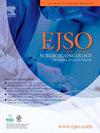Evaluation of risk-reducing radical fimbriectomy followed by delayed oophorectomy in high-risk Women: A single-center retrospective study
IF 2.9
2区 医学
Q2 ONCOLOGY
引用次数: 0
Abstract
Background
Ovarian carcinoma is a leading cause of cancer-related mortality in women. Approximately 20 % of cases are hereditary, mainly BRCA mutations. Current clinical guidelines recommend bilateral salpingo-oophorectomy between ages 35–45 for high-risk individuals, leading to premature menopause. Given evidence supporting the tubal origin of most ovarian cancers, radical fimbriectomy followed by delayed oophorectomy may offer a menopause-sparing alternative for women refusing early ovariectomy.
Objective
To evaluate the oncologic safety and clinical outcomes of this two-step risk-reducing strategy.
Methods
This retrospective single-center study included all high-risk premenopausal women who had completed childbearing, declined BSO and underwent radical fimbriectomy between 2014 and 2022. The primary outcome was the incidence of ovarian or pelvic cancer following radical fimbriectomy, estimated using the Kalbfleisch-Prentice method. Secondary outcomes included surgical complications, tubal lesions, menopause onset, breast cancer incidence and delayed oophorectomy rate.
Results
A total of 132 women were included; 62.9 % had BRCA1, 25.8 % BRCA2, and 11.3 % other high-risk mutations (RAD51C, PALB2). No tubal lesions were found in 121 cases (91.7 %), while 11 (8.3 %) had abnormalities: one high-grade serous carcinoma, six serous tubal intraepithelial carcinoma, and four minor lesions. After a median 30.4-month follow-up, no high-grade serous carcinoma was reported. Delayed bilateral oophorectomy was performed in 24 women (18.5 %), and menopause occurred in 27 at a median age of 45. One pregnancy occurred post-fimbriectomy via assisted reproductive technology.
Conclusion
Radical fimbriectomy with delayed oophorectomy may be a safe and feasible option for high-risk women seeking to avoid early menopause. Longer-term prospective studies are needed.
评估降低风险的根治性纤维切除术后延迟卵巢切除术在高危妇女:一项单中心回顾性研究。
背景:卵巢癌是女性癌症相关死亡的主要原因。大约20%的病例是遗传性的,主要是BRCA突变。目前的临床指南建议在35-45岁之间的高危人群进行双侧输卵管-卵巢切除术,导致过早绝经。鉴于有证据支持大多数卵巢癌的输卵管起源,根治性纤维切除术后延迟卵巢切除术可能为拒绝早期卵巢切除术的妇女提供一种节省更年期的选择。目的:评价两步降低风险策略的肿瘤安全性和临床结果。方法:这项回顾性单中心研究纳入了2014年至2022年间完成生育、BSO下降并行根治性纤维切除术的所有高危绝经前妇女。主要结局是根治性纤维切除术后卵巢癌或盆腔癌的发生率,使用Kalbfleisch-Prentice法估计。次要结局包括手术并发症、输卵管病变、绝经时间、乳腺癌发病率和延迟卵巢切除术率。结果:共纳入132名女性;62.9%的人有BRCA1, 25.8%的人有BRCA2, 11.3%的人有其他高危突变(RAD51C, PALB2)。121例(91.7%)未发现输卵管病变,11例(8.3%)有异常:1例高级别浆液性癌,6例浆液性输卵管上皮内癌,4例轻微病变。在中位30.4个月的随访后,没有报告高级别浆液性癌。24名妇女(18.5%)接受了延迟双侧卵巢切除术,27名妇女绝经,中位年龄为45岁。1例妊娠发生在经辅助生殖技术进行纤维切除术后。结论:根治性纤维束切除术联合延迟性卵巢切除术对于寻求避免提前绝经的高危妇女是一种安全可行的选择。需要更长期的前瞻性研究。
本文章由计算机程序翻译,如有差异,请以英文原文为准。
求助全文
约1分钟内获得全文
求助全文
来源期刊

Ejso
医学-外科
CiteScore
6.40
自引率
2.60%
发文量
1148
审稿时长
41 days
期刊介绍:
JSO - European Journal of Surgical Oncology ("the Journal of Cancer Surgery") is the Official Journal of the European Society of Surgical Oncology and BASO ~ the Association for Cancer Surgery.
The EJSO aims to advance surgical oncology research and practice through the publication of original research articles, review articles, editorials, debates and correspondence.
 求助内容:
求助内容: 应助结果提醒方式:
应助结果提醒方式:


